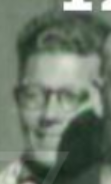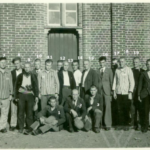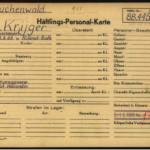Gommert Krijger
- Date of Death: 10 February 1951
- Place of Birth: Rilland Bath, Zeeland, The Netherlands
- Date of Deportation: 5 March 1943
- Address when Deported: Noordwijk, The Netherlands
- Place of deportation: Alderney
- Sites deported to: Sylt SS camp,
By Daan Stokvis
Dr. Krijger worked as a nerve specialist at the Dr. Mr. Willem van den Bergh Foundation, a nursing home for children and people with severe mental disabilities in Noordwijk, before becoming a prisoner due to resistance against the German occupiers in 1942. The fact that he was still working as a doctor until April 1942 shows that he was not Jewish (despite unfounded speculation) as Jews were prohibited from treating non-Jewish patients from May 1941 in the Netherlands. There are no camp documents, nor birth or death documents, that suggest a Jewish heritage.
Krijger’s resistant activities started when it was announced through local newspapers that all objects made of copper, nickel, tin, lead, brass, and alloys had to be handed over to the authorities. The Dr. Mr. Willem van den Bergh foundation decided not to comply and created a secret place to hide these objects. Krijger was one of the people who concealed items in this room. Unfortunately, it was discovered by German soldiers after a search of the foundation’s building. The soldiers were searching for weapons but found the secret room containing, among other things, Krijger’s belongings.
Following this finding, Krijger faced interrogation by the Gestapo in The Hague. Despite denying accusations of resistance and sabotage, he admitted to not surrendering copper and tin. Evading capture initially after this questioning, Krijger voluntarily returned to The Hague on June 12, 1942, to assist the former director of the Foundation who was still imprisoned in the infamous Oranjehotel (the nickname for Scheveningen prison). In this prison, Krijger wanted to plead for his colleague, but after another interrogation, he was also locked up. After weeks in The Hague, Krijger was transferred to the concentration camp in Amersfoort. This was the start of his long journey as a prisoner in the Netherlands, Germany, and Alderney, which continued until his eventual escape in Belgium in 1944.
In 1942, Krijger was transferred to Sachsenhausen concentration camp in Germany. Upon arrival, he and his fellow prisoners were greeted by several hundred S.S. soldiers, many of whom were armed with clubs, which were used to beat the prisoners into rows of five. The camp was surrounded by a five-meter-high wall with watchtowers staffed by S.S. guards armed with machine guns. In this violent atmosphere, Dr. Krijger experienced overwhelming fatigue and a sense of hopelessness. These feelings were heightened when Krijger witnessed, within three days of being in the camp, the sight of carts loaded with dead bodies being transported to the crematoria.
Krijger found his ‘escape’ out of Sachsenhausen via the foundation of the first SS Baubrigade. This construction team was created in October 1942 and was composed of prisoners who were forced to build constructions necessary for the war efforts of the Nazis, such as V-weapons sites, roads, and bunkers. In this SS Baubrigade, Krijger functioned as a doctor, which was very needed due to the lack of proper nutrition and diseases like dysentery, which took a severe toll on the prisoners’ health. In the first months of the Baubrigade’s existence, when the group worked near Düsseldorf, Dr. Krijger found himself simultaneously acting as a nurse and doctor, despite his own malnourished state. He witnessed the suffering of young men, mostly between the ages of 17 and 25, who were weakened by illness and hunger, with little hope of recovery.
In February 1943, the Baubrigade was forced to travel to France. According to Krijger, around one thousand prisoners were transported in cattle wagons to St-Malo. In this town, the SS Baubrigade was stationed in old barracks for a few days until shipped to Alderney on 25 February 1943. In his book that Krijger wrote about his experiences as a prisoner in 1944, on which this text is based, not much is mentioned on the exact places Krijger lived in Alderney; however he stated that his stay on Alderney was the hardest period in his life.
Upon arrival in Alderney, Dr. Krijger and his fellow prisoners were placed in a barracks camp on a windswept plateau. Krijger did not mention the name of this camp in his book, but it is likely to have been Sylt SS camp because this is known to have been the destination of the Baubrigade. The conditions were harsh, with the wind penetrating through the unfinished walls, and the prisoners had to suffer extreme cold. Besides the climate on Alderney, the food rations were again inadequate. The food was barely sufficient for survival, let alone in combination with the physical labour the Baubrigade had to endure. A combination of these factors (housing, climate, food, and labour) caused widespread illness and weakness among the prisoners. Dysentery quickly spread among the inmates, claiming numerous lives. Krijger tried to save as many as possible but could not provide the right treatment to the sick; medical supplies for prisoners were scarce in Alderney.
The death toll was high on Alderney not only due to sickness but also because of the brutality and violence of the SS guards. Many prisoners were shot by guards for so-called ‘illegal actions’ or simply because they were too weak to work. According to Krijger, men were also hanged for minor offences such as stealing potatoes to satisfy hunger. Due to this deadly reality, desperation was high within the Baubrigade, which led to difficult acts of survival, including eating the rats found around the barracks.
The evacuation of Alderney on 24 June 1944 marked the end of a period of intense suffering for Krijger. After enduring seventeen months of misery, according to Krijger only about six hundred of the original thousand members of the Baubrigade remained and were sent to Kortemark in Belgium. During the journey, the prisoners faced continuous peril, with some being shot or wounded along the way (including two fellow Dutchmen). Many suffered from severe tuberculosis, resulting in again a significant loss of life during the transit. Despite their weakened state, Krijger claimed that many prisoners still believed in survival.
Upon their arrival in Kortemark on 28 July 1944, the remaining group of 553 men, including Krijger, were split, with 335 staying in Kortemark and 218 being taken to Proven. The prisoners who stayed in Kortemark were assigned to work at V1 launch bases in West Flanders. During this period, Krijger finally had enough nutrition due to the help of the local population. However, On 31 August 1944, the Baubrigade was ordered to prepare to depart for Germany. Many, including Krijger, suspected that their ultimate destination would be Buchenwald, and started to make good relationships with the local population in Kortemark. Due to these two factors, many members of the Baubrigade thought about escaping the forced move to Germany. Forty-two prisoners attempted an escape, during which three prisoners were shot, and thirty-nine managed to evade the German authorities, including Krijger. After his escape, Krijger and a Polish survivor of the Baubrigade wrote a book about their lives in imprisonment and toured Belgium and the Netherlands to tell about the horrors he had to endure in 1945.
Although Krijger initially survived his imprisonment during the Second World War, these terrible experiences claimed his life on 10 February 1951, after serving as a doctor in Harderwijk for five years. According to a local newspaper, Krijger’s death came after a prolonged illness, but the exact nature of which was not specified. However, it is mentioned that his declining health may have been indirectly linked to the hardships he endured during his time as a prisoner. He was only 46 years old at the time of his passing, leaving his wife and six children behind.
Sources:
- ‘ALDERNEY (1ST SS CONSTRUCTION BRIGADE)’. Link: Satellite camps (kz-gedenkstaette-neuengamme.de)
- Duitschlands folterkampen! Oranienburg – Sachsenhausen: Amersfoort – Duisburg – Düsseldorf en eiland Alderney verteld door: heer Jan Woitas: Pool en dokter G. Krijger: Nederlander: van hunne gevangenneming tot hunne ontvluchting!. — S.l.: s.n., [c. 1945].
- ‘Kortemark: bijeenkomst ontsnapte politieke gevangenen Markhove’. Link: ontdek de beelden (westhoekverbeeldt.be)
Map
- Cemetery / Mass Grave
- Concentration Camp
- Forced Labour Camp
- Prison
- Worksite / Fortification


